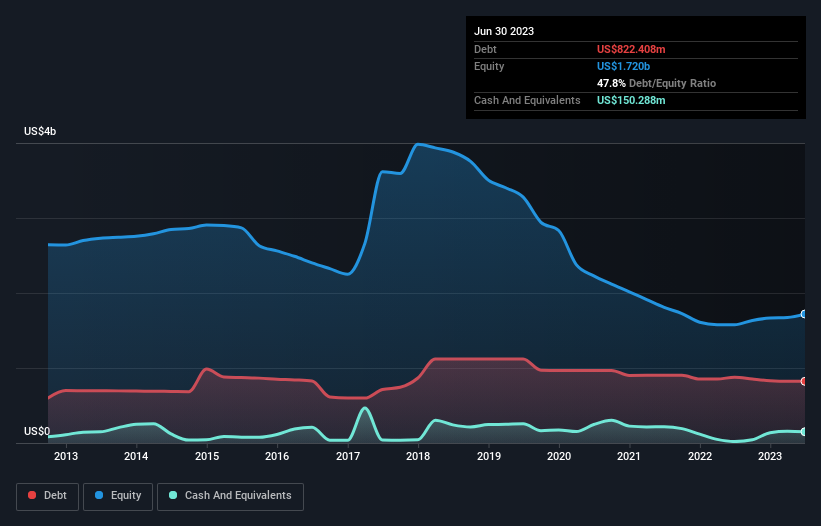- United States
- /
- Energy Services
- /
- NasdaqGS:PTEN
These 4 Measures Indicate That Patterson-UTI Energy (NASDAQ:PTEN) Is Using Debt Reasonably Well

The external fund manager backed by Berkshire Hathaway's Charlie Munger, Li Lu, makes no bones about it when he says 'The biggest investment risk is not the volatility of prices, but whether you will suffer a permanent loss of capital.' When we think about how risky a company is, we always like to look at its use of debt, since debt overload can lead to ruin. We note that Patterson-UTI Energy, Inc. (NASDAQ:PTEN) does have debt on its balance sheet. But the more important question is: how much risk is that debt creating?
When Is Debt A Problem?
Debt assists a business until the business has trouble paying it off, either with new capital or with free cash flow. If things get really bad, the lenders can take control of the business. However, a more common (but still painful) scenario is that it has to raise new equity capital at a low price, thus permanently diluting shareholders. Of course, debt can be an important tool in businesses, particularly capital heavy businesses. When we think about a company's use of debt, we first look at cash and debt together.
Check out our latest analysis for Patterson-UTI Energy
How Much Debt Does Patterson-UTI Energy Carry?
You can click the graphic below for the historical numbers, but it shows that Patterson-UTI Energy had US$822.4m of debt in June 2023, down from US$877.7m, one year before. However, because it has a cash reserve of US$150.3m, its net debt is less, at about US$672.1m.

How Strong Is Patterson-UTI Energy's Balance Sheet?
We can see from the most recent balance sheet that Patterson-UTI Energy had liabilities of US$454.3m falling due within a year, and liabilities of US$942.7m due beyond that. Offsetting these obligations, it had cash of US$150.3m as well as receivables valued at US$503.4m due within 12 months. So it has liabilities totalling US$743.3m more than its cash and near-term receivables, combined.
While this might seem like a lot, it is not so bad since Patterson-UTI Energy has a market capitalization of US$3.57b, and so it could probably strengthen its balance sheet by raising capital if it needed to. But we definitely want to keep our eyes open to indications that its debt is bringing too much risk.
We use two main ratios to inform us about debt levels relative to earnings. The first is net debt divided by earnings before interest, tax, depreciation, and amortization (EBITDA), while the second is how many times its earnings before interest and tax (EBIT) covers its interest expense (or its interest cover, for short). The advantage of this approach is that we take into account both the absolute quantum of debt (with net debt to EBITDA) and the actual interest expenses associated with that debt (with its interest cover ratio).
Patterson-UTI Energy has a low net debt to EBITDA ratio of only 0.72. And its EBIT covers its interest expense a whopping 12.3 times over. So you could argue it is no more threatened by its debt than an elephant is by a mouse. It was also good to see that despite losing money on the EBIT line last year, Patterson-UTI Energy turned things around in the last 12 months, delivering and EBIT of US$428m. There's no doubt that we learn most about debt from the balance sheet. But it is future earnings, more than anything, that will determine Patterson-UTI Energy's ability to maintain a healthy balance sheet going forward. So if you're focused on the future you can check out this free report showing analyst profit forecasts.
Finally, a business needs free cash flow to pay off debt; accounting profits just don't cut it. So it's worth checking how much of the earnings before interest and tax (EBIT) is backed by free cash flow. Over the last year, Patterson-UTI Energy recorded free cash flow worth a fulsome 89% of its EBIT, which is stronger than we'd usually expect. That positions it well to pay down debt if desirable to do so.
Our View
Patterson-UTI Energy's interest cover suggests it can handle its debt as easily as Cristiano Ronaldo could score a goal against an under 14's goalkeeper. And that's just the beginning of the good news since its conversion of EBIT to free cash flow is also very heartening. Zooming out, Patterson-UTI Energy seems to use debt quite reasonably; and that gets the nod from us. After all, sensible leverage can boost returns on equity. There's no doubt that we learn most about debt from the balance sheet. However, not all investment risk resides within the balance sheet - far from it. For example, we've discovered 3 warning signs for Patterson-UTI Energy (1 doesn't sit too well with us!) that you should be aware of before investing here.
If you're interested in investing in businesses that can grow profits without the burden of debt, then check out this free list of growing businesses that have net cash on the balance sheet.
New: Manage All Your Stock Portfolios in One Place
We've created the ultimate portfolio companion for stock investors, and it's free.
• Connect an unlimited number of Portfolios and see your total in one currency
• Be alerted to new Warning Signs or Risks via email or mobile
• Track the Fair Value of your stocks
Have feedback on this article? Concerned about the content? Get in touch with us directly. Alternatively, email editorial-team (at) simplywallst.com.
This article by Simply Wall St is general in nature. We provide commentary based on historical data and analyst forecasts only using an unbiased methodology and our articles are not intended to be financial advice. It does not constitute a recommendation to buy or sell any stock, and does not take account of your objectives, or your financial situation. We aim to bring you long-term focused analysis driven by fundamental data. Note that our analysis may not factor in the latest price-sensitive company announcements or qualitative material. Simply Wall St has no position in any stocks mentioned.
About NasdaqGS:PTEN
Patterson-UTI Energy
Through its subsidiaries, provides drilling and completion services to oil and natural gas exploration and production companies in the United States and internationally.
Very undervalued with excellent balance sheet.
Similar Companies
Market Insights
Community Narratives



